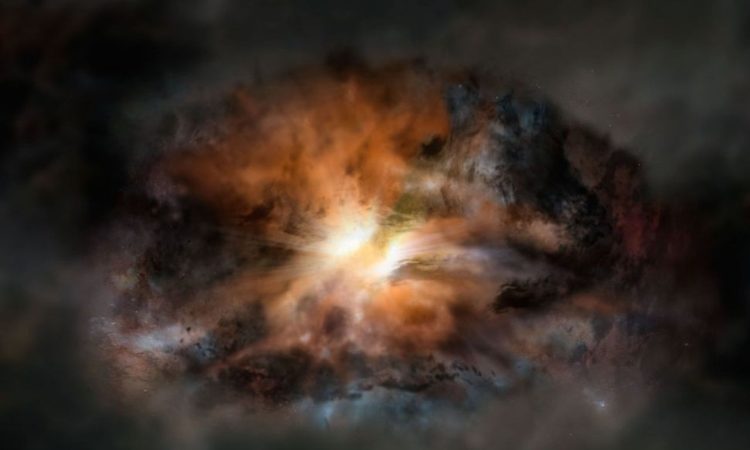
Earlier this year, scientists suggested that one of NASA’s Wide-field Infrared Survey Explorer (WISE) spacecraft could be responsible for discovering signals that would indicate the presence of megastructures used to capture energy from stars. These so-called “Dyson spheres” would be the sign of a highly advanced civilization capable of making major changes in their planetary systems. Or maybe a Dyson Sphere is “just” a Hot DOG.
Not everyone was convinced by these detections, however, and a scientist working with WISE (the space shuttle was renamed NEOWISE in 2013) is determined to set the record straight. It suggests that the signals are much more likely to represent dusty galaxies with massive black holes, called “Hot Dust-Obscured Galaxies”.
“As a member of the WISE team working on distant galaxies detected by WISE, the constant mention of ‘Dyson spheres’ since launch has been annoying,” said British astronomer Andrew Blain, a professor at the University of Leicester.
“The appearance of a study that almost said ‘here they are’ was the last straw!”, continues the astronomer. As humanity is quickly discovering, the price of being a technological civilization is tied to the immense energy demands of our inventions.
What is a Dyson Sphere?
The main source of energy in any planetary system is the central star, which means that extraterrestrial civilizations (if they exist) could call on their stars to directly extract the necessary energy, preventing it from leaking into space.
A “Dyson sphere” is a hypothetical megastructure that could surround a star and directly capture its energy. This technology was first suggested by physicist Freeman Dyson in 1960. Since then, many scientists have hunted for such possible structures, believing that the detection of such a structure would constitute evidence of a highly advanced extraterrestrial civilization, .
A possible signal of such a megastructure would be the detection of excess “waste heat” in the form of infrared radiation. The team known as Project Hephaistos is looking for such signals among 5 million stars, using data from WISE, Gaia and other telescopes.
In May 2024, Project Hephaistos in the magazine Monthly Notices of the Royal Astronomical Society (MRNAS), reporting the detection of seven unusual objects that could fit this pattern. These objects resembled red dwarf stars, the most common and long-lived stars in the Milky Way, but had an unusual infrared signature that could indicate the presence of Dyson spheres.
That was the spark that caused Blain to step in.
What is a “Hot DOG”?
He cautions that assuming such a signal indicates a Dyson sphere is a “risky” endeavor because of the noise associated with such a large sample of stars. And more importantly, he draws attention to the confusion with emission from dusty background galaxies, especially Hot DOGs.
“The number of Hot DOGs in a given patch of sky is exactly enough to find seven in the area surveyed by WISE. And there are definitely Hot DOGs, while it’s not at all clear if there are Dyson Spheres,” Blain said.
Hot DOGs are extremely powerful galaxies with a central They are dark in visible light because of the dust shells that surround them, but they are bright in the infrared, which can pass through these dust layers.
WISE discovered the first Hot DOGs in the early 2010s. Their population also includes WISE J224607.57−052635.0 (W2246-0526), which, upon its discovery in 2015, was listed as the “brightest galaxy” ever observed.
Why can these two things be confused?
Blain also explained why Hot DOG galaxies could be mistaken for Dyson spheres in the WISE data.
“If the Hot DOG galaxy were behind a star searched for a ‘Dyson sphere’, it would look similar. With 5 million stars analyzed, finding seven Hot DOGs close to one star is exactly what you’d expect to find. We purposely avoided looking for Hot DOGs behind the stars, as this prevents their visibility in optical light,” he said.
Blain concludes that speculation about Dyson spheres detected by WISE is unfounded.
“I think it’s clear: Dyson spheres may exist, but they’re unlikely to be what we’re seeing here. Observations of these objects could still be very useful, as few Hot DOGs have been studied in detail,” he said.
“Furthermore, I realized that any group of aliens capable of building a Dyson sphere would be equally capable of hiding it by sending us a false signal. I find that interesting, they could be hiding in the cosmos and we wouldn’t be able to detect them,” the scientist continues.
While some may be disappointed by the possibility of Dyson spheres being removed from the discussion, Blain has other concerns. “I was more disappointed that WISE data was being used in such a speculative topic,” he said.
Blain’s research is published on .

